The 8 Best Knife Sharpeners to Keep Your Blades Razor Sharp
When was the last time you sharpened your knives? Odds are, not recently enough. According to Eric Rivera, chef and founder at Addo in Seattle and former Director of Culinary Research at Alinea, you should sharpen your knives every one to three months if you’re cooking daily.
“Most people only think about it when Thanksgiving rolls around and they suddenly have to chop a bunch of things,” he said over the phone. “But sharp knives are key.”
Though it may seem like a fussy step only necessary for professional chefs, sharp knives make such a difference in everything from dicing vegetables to more technical cuts, like filleting fish. Not only are sharp blades easier to use, they also lead to fewer accidents, which might happen when you’re forced to hack away at things that should only require an easy slice (just ask the scar on my pointer finger).
RELATED: The Best Knife Sets on Amazon, According to Reviews
Now, you could take your knives to a specialty kitchen store or hit up a sharpening service, but we think it’s worth investing in a home solution to give your blades a tune up anytime you need. But where do you start? Do you drop a chunk of change on a fancy all-in-one appliance or go for a cheaper DIY option that requires you to watch a few YouTube videos to get the hang of? Or does that long metal rod that comes in knife sets do the trick?
Rest easy. We researched all the best knife sharpening options out there for every need, budget, and involvement level, so you don’t have to. And what’s more, they’re all available to order on Amazon. Whether you need a wallet-friendly tool or are looking for a do-it-all upgrade, these best-selling sharpeners have near-perfect ratings and rave reviews describing why they’re so great.
Best Manual Sharpener: Chef’s Choice by Edgecraft
Best Electric Sharpener: Work Sharp Culinary E5
Best Sharpening Stone: Sharp Pebble
Best Entry-Level Electric Sharpener: Presto EverSharp
Best Entry-Level Manual Sharpener: PriorityChef
Best Budget-Friendly Sharpener: KitchenIQ Edge Grip
Best Quick Fix: Accusharp
Best Keeper-Upper: Cooks Standard Professional Ceramic Rod
Read on to discover more about these top-rated knife sharpeners. Then get ready to revel in the ease of chopping, slicing, and dicing in the kitchen with your new razor-sharp blades.
Best Manual Sharpener: Chef’s Choice by Edgecraft
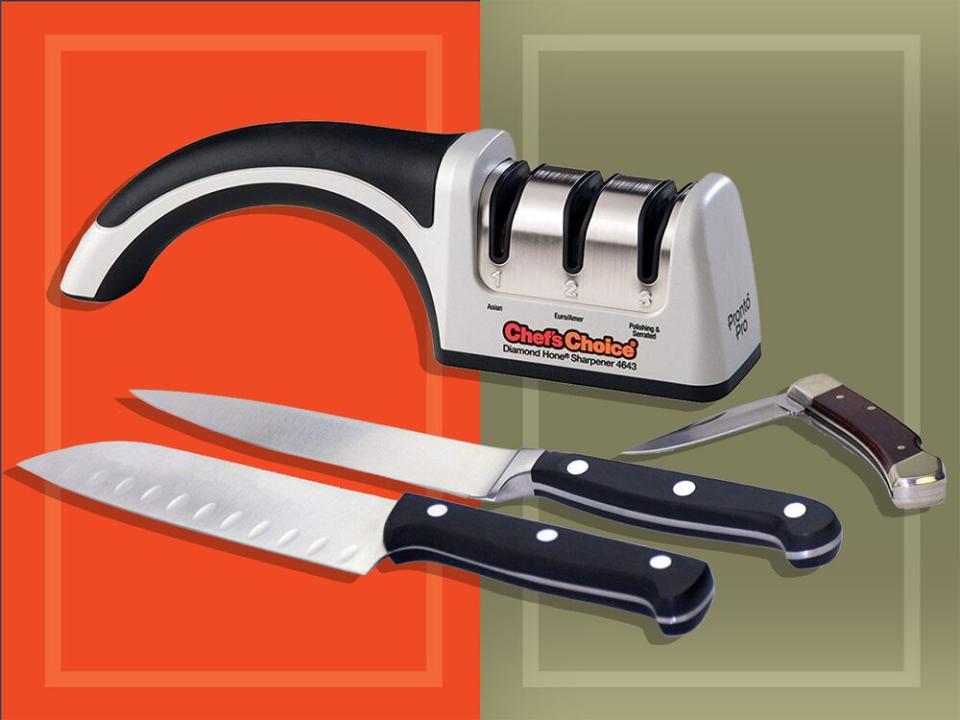
If you’re looking for a foolproof option to reinvigorate your dull knives, Chef’s Choice is a good, er, choice. The three-stage sharpener has 100 percent diamond abrasives, which gradually hone blades before polishing edges to smooth sharpness. It works on both straight-edged and serrated blades, and features precise bevel angle control that applies 15-degree edges for Asian-style knives and 20-degree edges for European- and American-style knives.
Amazon reviewers agree that the Chef’s Choice is a great all-around sharpener to have in your kitchen, giving it an average of 4.3 stars. One even noted that the Chef’s Choice worked markedly better than her electric sharpeners. And at $36, it’s comparatively much cheaper than many electric options.
“I've now sharpened about fifty knives with my Model 4643, including several Shun's and carbon steel Chinese cleavers and it still restores hair-popping edges on my heavily used MAC 8 ½-inch chef’s knife,” one user wrote. “I can now cut ripe tomatoes and crusty bread without a serrated knife because the blade is so sharp. Plus it’s so small, it stores in a drawer for handy access. Sharpens both sides of the blade on both forward and backward strokes.”
To buy: $36; amazon.com
Best Electric Sharpener: Work Sharp Culinary E5 Kitchen Knife Sharpener with Ceramic Honing Rod
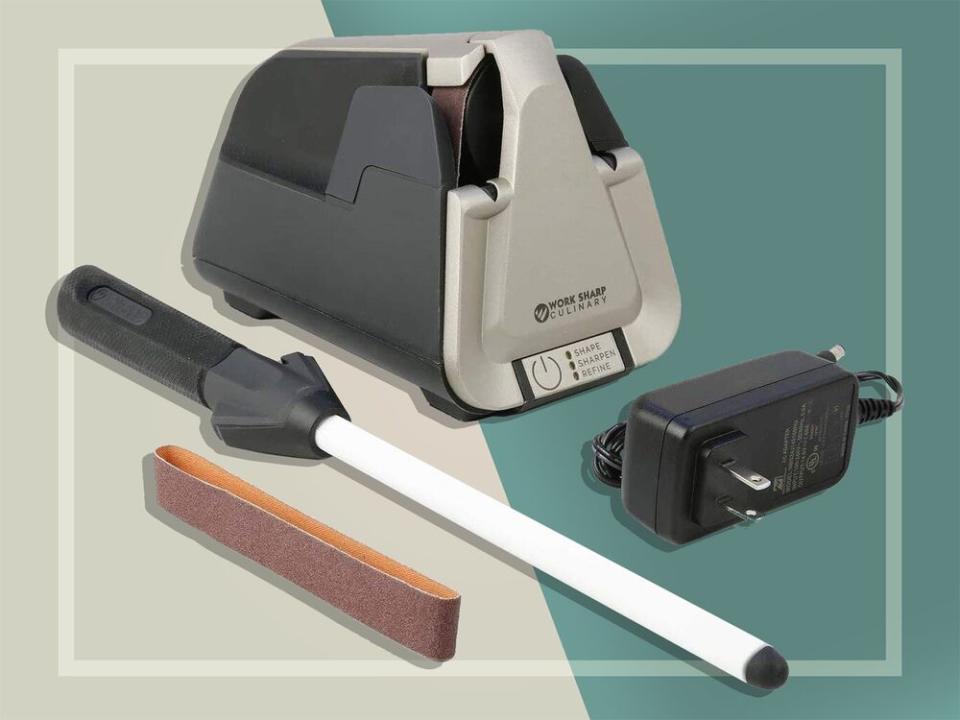
When I opened up the Work Sharp Culinary E5 I was slightly intimidated by how high-tech it looked. Thankfully, it’s a breeze to use. You can run the machine at three settings controlled by a button: Shape, Sharpen, and Refine. The Shape setting nudges your knife’s edge back to its proper angle, while the Sharpen create razor-thin edges, and the Refine smooths out any burrs. The tool also comes with a ceramic honing rod, so you can keep your knives at their best in between sharpening sessions. Bonus: It works with all types of blades, including kitchen scissors, pocket knives, and even serrated knives.
I had some pretty dull knives, so I started with the Shape setting. A narrow belt started whirring quickly after I pressed the button, and I physically felt the spinning belt sand the blade down when I inserted my knife’s edge into one of the slots. It was louder than I expected, but it made me feel like the device was actually doing something. After the cycle was done (the Work Sharp automatically turns off at the end of each cycle), I moved onto Sharpen, then Refine. I had to go through two rounds for one of my especially dull knives, but the entire process took less than five minutes total. Pretty speedy! And my knives were sharper than they’d been in years.
At almost $200, the Work Sharp isn’t cheap. However, if you want an option that can handle a wide variety of blades and requires little-to-no effort on your part, it could be a good investment. Amazon reviewers generally agree, praising the machine for its user-friendliness and professional-level power.
“This is easily the best knife sharpener I've ever used,” one wrote. “I have a rather expensive set of kitchen knives, and they were getting dull, so I took them to a store to have them professionally sharpened. I asked what they used, and they showed me this sharpener. I use it once a month or so on the knives I use most often, and they are as sharp as the day I bought them. This sharpener is worth every penny.”
To buy: $200; amazon.com
Best Sharpening Stone: Sharp Pebble
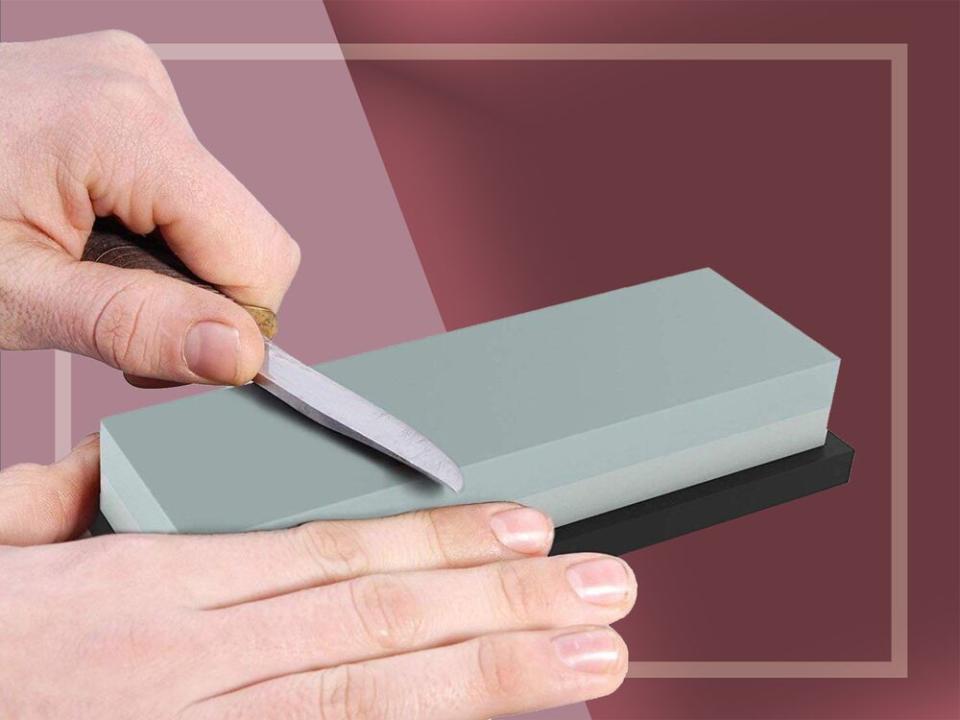
The Sharp Pebble is a whetstone, which is a texture block for DIY sharpening. Most professional chefs say whetstones are the only way they sharpen their knives. Unlike electric and manual sharpeners, which have fixed blades to sharpen edges to a precise angle, whetstones allow a higher degree of freedom so you can hone blades to any angle with greater control.
One downside of using a whetstone, though, is that you have to practice a bit to know what you’re doing. When I asked Rivera why he thought more home cooks didn’t use whetstones, he summed it up in one word: “patience.” The stone has to be soaked for roughly ten minutes before use and periodically re-wet during the sharpening process. It also takes anywhere from five to ten minutes per side, and even longer when you’re first getting the hang of it.
If you do choose to try out a whetstone, however, you’ll be rewarded with a super-sharp blade and the pride of knowing you executed it just like a professional chef. (Just make sure to watch a YouTube video to learn how to use them first.) Whetstones are also more versatile than most other sharpeners. In addition to knives, you can sharpen scissors, gardening tools, and bigger blades like axes (you know, in case you have an axe on hand that needs sharpening).
The Sharp Pebble is one of Amazon’s best-rated whetstones, with more than 500 five-star reviews. It’s made from highly durable silicon carbide and designed with a 400-grit side for the extensive grinding and the 1000-grit side to smooth and polish the edge. It also comes with a slip-resistant rubber base to hold the stone while sharpening, as well as flattening stone to reshape and level the sharpener.
I tried out the Sharp Pebble, and while it certainly wasn’t as easy an experience as some of the other sharpeners I tested, it was actually the most fun to use. I watched a few DIY knife sharpening videos online while I soaked my stone, then ran the blade of my knife up and down along the coarser stone for a few minutes, moving it around to concentrate on different areas. I then switched to the smoother stone to polish it. Overall my knife wasn’t as dramatically transformed as the others that I sharpened on the electric and even manual options. However, with practice I think I could learn to sharpen my blades with the whetstone.
To buy: $26; amazon.com
Best Entry-Level Electric Sharpener: Presto EverSharp
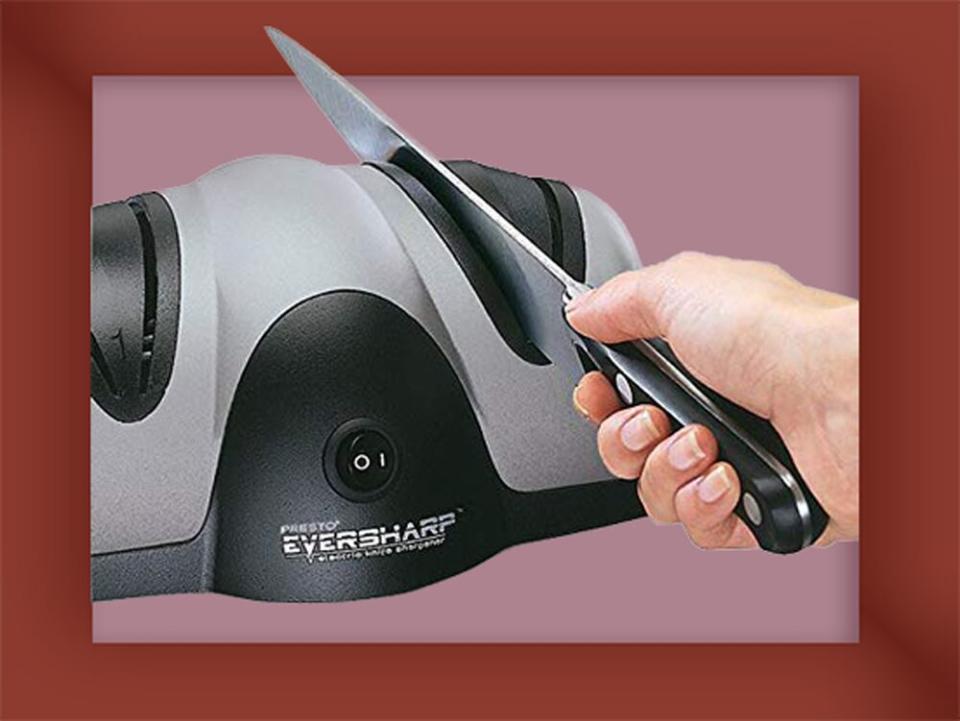
Even if you’re a knife sharpening newbie, the Presto Ever Sharp Electric Knife Sharpener will get your blades in top shape. It has a two-stage system that quickly sharpens any non-serrated edge and is designed with a guide to position your knife at the perfect sharpening angle without guesswork. First the wheels grind an angled edge into the blade, then the edge is honed and polished smooth. The Presto also uses sapphirite sharpening wheels, which is the same super-hard material used in professional shops.
No wonder it’s one of the best-reviewed knife sharpeners on Amazon, with nearly 2,000 five-star ratings. “Idiot-proof,” one reviewer wrote, “There's an immediate noticeable difference in the way [knives] cut after just a couple runs through the Presto sharpener.”
Another user tried the Presto sharpener as a last-ditch effort on his dull knives before investing in a new set. “I am extremely happy with the edge this device has put on our knives. It's like they are brand new again!”
I actually got a Presto sharpener to test out myself and was pleased with the results. Using it is simple: Plug in the machine, insert your knife into one of the grooves on the first side, slide it through ten times for a few seconds each, then repeat on the other side to sharpen both sides of the blade. After that, repeat on the other side to smooth the blade.
The machine can get a bit loud, but my knife’s edge was noticeably sharper by the time I finished the process, which only took around thirty seconds. In addition to my chef’s knife, I sharpened a few of my paring knives and also had excellent results.
The Presto sharpener also a pretty sweet price point for such a high-quality experience. As one reviewer put it: “Would I recommend? Unless you want to spend $200 for the best ever with diamond blades, this is your new best friend. Yes, yes, yes.”
To buy: $26 (originally $43); amazon.com
Best Entry-Level Manual Sharpener: PriorityChef Knife Sharpener
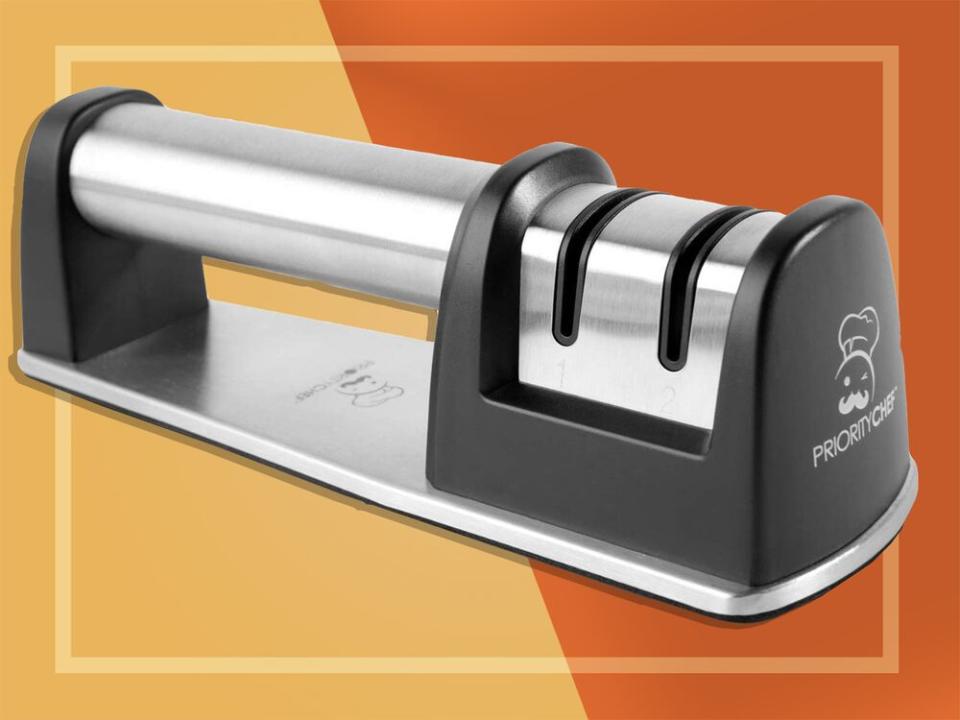
At just under $16, the PriorityChef Knife Sharpener is practically a steal for anyone looking to try sharpening knives, themselves. Its straightforward two-stage sharpening system first grinds straight-edged blades into the right shape with a diamond-coated coarse wheel, then polishes them to a razor edge with a ceramic fine wheel. Pass knives through each opening about ten times, and your edges will have new life in mere minutes. It even works on serrated knives! Just make sure to only run through the ceramic opening.
Thousands of Amazon shoppers have been impressed with PriorityChef’s Knife Sharpener, praising the tool for how comfortable it is to hold and use. “It was easy, it was quick, and the results were gratifying,” wrote one reviewer. “I hope this sharpener lasts a long time, because I don't think I want to be without it.”
Another commented that the low cost of the sharpener originally had them skeptical, but they were very pleased with their purchase. “Don’t let the low price throw you — this is an excellent sharpener,” they wrote. “I just sharpened every knife I own in lickity split time and they are razor sharp.”
To buy: $16; amazon.com
Best Budget-Friendly Sharpener: KitchenIQ Edge Grip
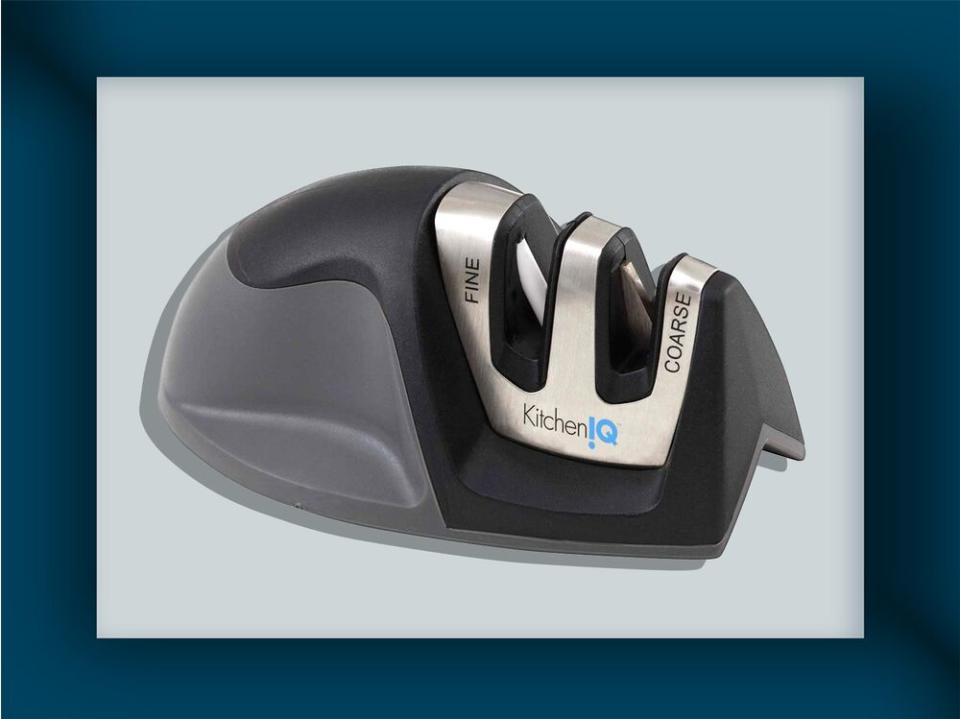
It may be low in price and small in stature, but the KitchenIQ Edge Grip can still deliver a pretty sharp edge to your dullest blades. The device comes with two sharpening options: The coarse setting has carbide blades which quickly set a knife’s edge, and the fine setting consists of ceramic rods to hone just-sharpened blades or provide quick touch-ups to keep your knife at its best between sharpenings. It also features a non-slip base for stability and easy control, while its tiny size (it fits in your palm!) makes it ideal for small kitchens.
With more than 7,800 five-star reviews, Amazon users agree it delivers an excellent experience for the price.
“I decided to purchase this sharpener with a bit of skepticism that it could rehab some dull knives in the drawer,” wrote one reviewer. “I figured it's less expensive than taking my knives into a shop to have sharpened. I have this bottom of the line Henckels chef's knife that couldn't cut through the skin of a tomato. I ran my knife through the coarse sharpener eight times then four times on the fine side. I could literally feel the metal being shaved off the edges.The major test was the following morning cutting through an unpeeled onion and a tomato. What was the worst knife in the kitchen is now a serviceable tool.”
To buy: $6; amazon.com
Best for Quick Fixes: Accusharp Knife Sharpener

If you’re looking for a knife sharpener to give your blades a super-quick quick makeover, the Accusharp is worth checking out. This little device wraps around your hand (don’t worry, there’s a plastic guard to protect your fingers), then you drag your knives through the angled tungsten sharpening blades ten times. It’s low maintenance, fits easily in a kitchen drawer, and is incredibly simple to use.
Nonetheless, the Accusharp is one of the most polarizing knife sharpening options out there. Some say that the super-affordable device is a budget-friendly miracle for saving dull knives. Others argue it’s too aggressive and destroys blades without properly sharpening them. The truth lies somewhere in the middle.
I tried out the Accusharp on my big kitchen cleaver, which I picked up for cheap years ago and often use to hack through stubborn vegetables. After just a few swipes, the blade was noticeably sharper and made slicing through a butternut squash much less of an arm workout. However, since the sharpener only has one angle, I’m hesitant to use it on some of my fancier knives, especially the Japanese ones which have more of a slanted blade angle.
Regardless, for a quick sharpening fix, the Accusharp is tough to beat. Plus it stows away easily in my kitchen drawer, which is nice when counter space is at a premium.
To buy: $10 (originally $15); amazon.com
Best Keeper-Upper: Cooks Standard Professional Ceramic Rod
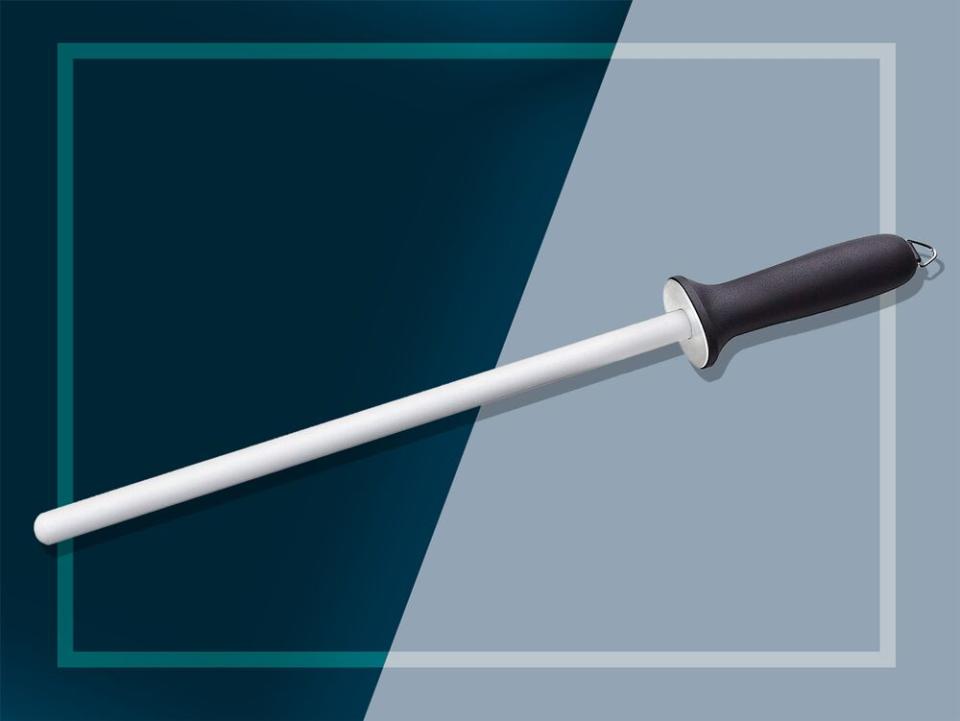
A honing rod is not a standalone knife sharpener. Instead, the long rod, which typically comes in metal, diamond carbon steel or ceramic, keeps knives in ship shape in between more intensive sharpening sessions. It takes a few practices to get the hang of the honing motion, in which you run the blade of the knife alongside the rod at an angle. However, once you fall into a rhythm it’s an oddly satisfying ritual. Hone your knives once every week or so to make sure they stay at their sharpest, as well as to extend the amount of time between sharpenings.
I like ceramic honing steels because they’re harder than metal counterparts, but softer than diamond carbon steel. That means they work on harder knives, like Japanese ones, but are also gentle enough to give your blade a super fine edge. Cooks Standard Professional Ceramic Rod is Amazon’s Choice for ceramic knife sharpeners, with an impressive 4.6-star rating. Users rave about how well made the rod is, saying it outperforms more expensive versions.
“Having owned several sharpening steels from discount stores to $75+ Sabatier, the feel and bite of this beats diamond, hands down,” one wrote. “After a basic 300 to 3000 grit stone honing, this thing is wonderful for refreshing the scalpel-like edge to my knives for weeks before needing to head back to the stones.”
To buy: $23 (originally $25); amazon.com

